check engine light Citroen C4 PICASSO 2008.5 1.G Owner's Manual
[x] Cancel search | Manufacturer: CITROEN, Model Year: 2008.5, Model line: C4 PICASSO, Model: Citroen C4 PICASSO 2008.5 1.GPages: 330, PDF Size: 13.17 MB
Page 19 of 330
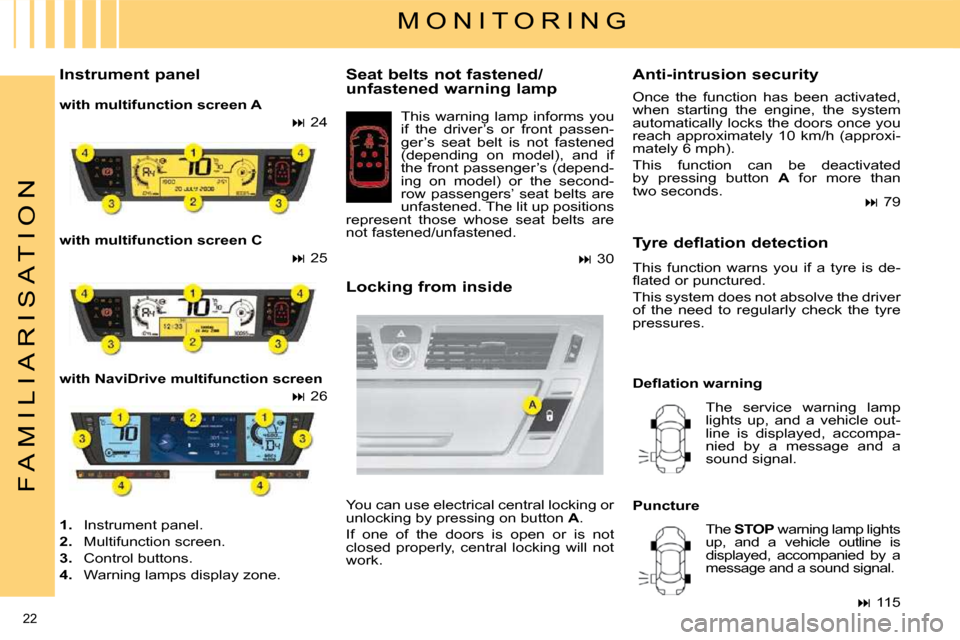
22
F A M I L I A R I S A T I O N
Seat belts not fastened/
unfastened warning lamp This warning lamp informs you
if the driver’s or front passen-
ger’s seat belt is not fastened
(depending on model), and if
the front passenger’s (depend-
ing on model) or the second-
row passengers’ seat belts are
unfastened. The lit up positions
represent those whose seat belts are
not fastened/unfastened.
You can use electrical central locking or
unlocking by pressing on button A .
If one of the doors is open or is not
closed properly, central locking will not
work. Tyre deflation detection
This function warns you if a tyre is de-
�fl� �a�t�e�d� �o�r� �p�u�n�c�t�u�r�e�d�.�
This system does not absolve the driver
of the need to regularly check the tyre
pressures.
The service warning lamp
lights up, and a vehicle out-
line is displayed, accompa-
nied by a message and a
sound signal.
� � �D�e�fl� �a�t�i�o�n� �w�a�r�n�i�n�g� �
The STOP warning lamp lights
up, and a vehicle outline is
displayed, accompanied by a
message and a sound signal.
Puncture
� 30
� 115
Anti-intrusion security
Once the function has been activated,
when starting the engine, the system
automatically locks the doors once you
reach approximately 10 km/h (approxi-
mately 6 mph).
This function can be deactivated
by pressing button
A for more than
two seconds.
� 79
M O N I T O R I N G
Locking from inside
Instrument panel
with multifunction screen A
� 24
with multifunction screen C
� 25
with NaviDrive multifunction screen
� 26
1. Instrument panel.
2. Multifunction screen.
3. Control buttons.
4. Warning lamps display zone.
Page 21 of 330
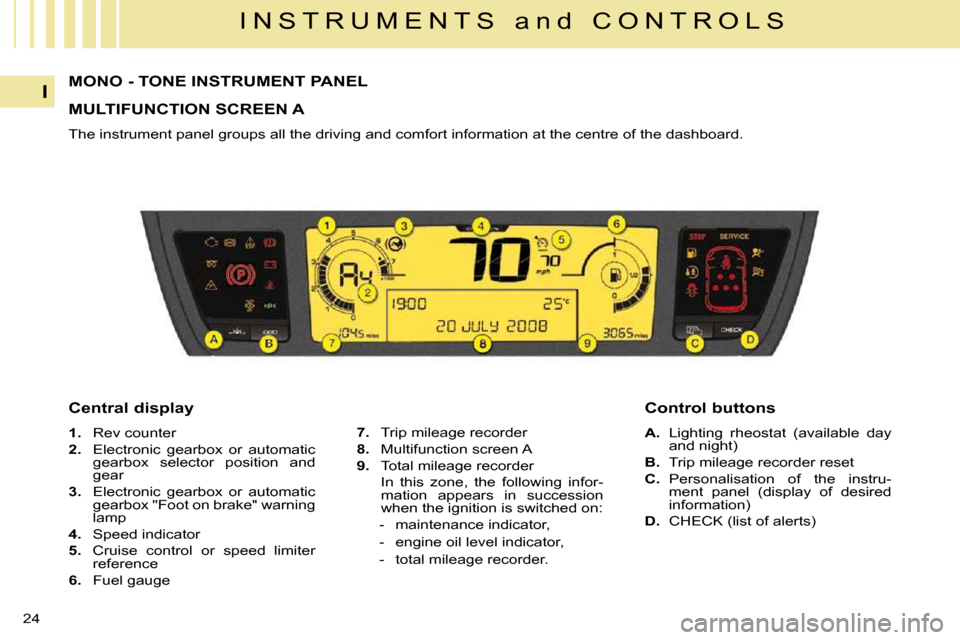
24
I
I N S T R U M E N T S a n d C O N T R O L S
MONO - TONE INSTRUMENT PANEL
MULTIFUNCTION SCREEN A
The instrument panel groups all the driving and comfort information at the centre of the dashboard.
Central display
1. Rev counter
2. Electronic gearbox or automatic
gearbox selector position and
gear
3. Electronic gearbox or automatic
gearbox "Foot on brake" warning
lamp
4. Speed indicator
5. Cruise control or speed limiter
reference
6. Fuel gauge
7. Trip mileage recorder
8. Multifunction screen A
9. Total mileage recorder
In this zone, the following infor- mation appears in succession
when the ignition is switched on:
- maintenance indicator,
- engine oil level indicator,
- total mileage recorder. Control buttons
A. Lighting rheostat (available day
and night)
B. Trip mileage recorder reset
C. Personalisation of the instru-
ment panel (display of desired
information)
D. CHECK (list of alerts)
Page 46 of 330
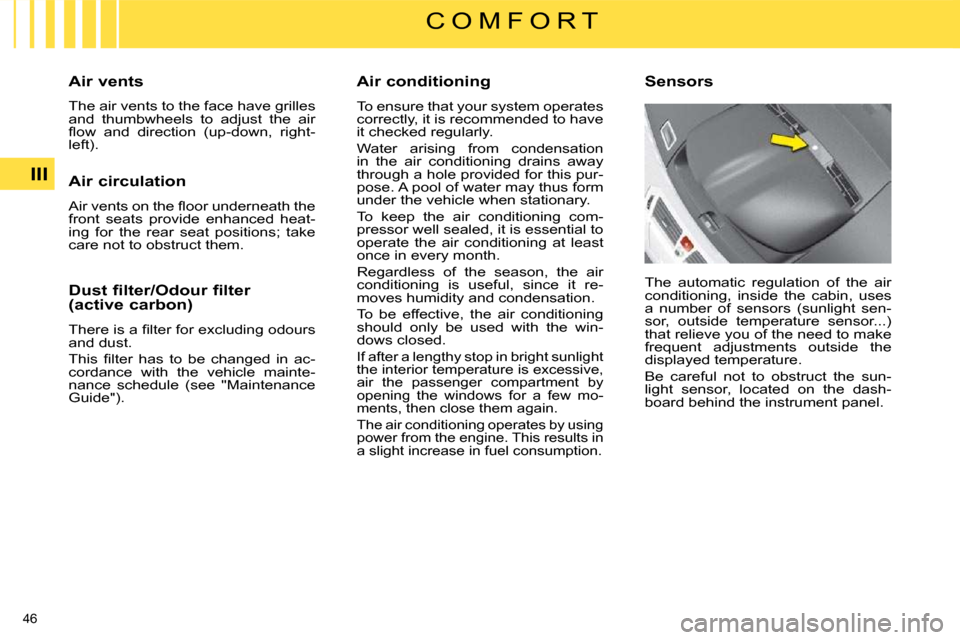
46
III
C O M F O R T
Air conditioning
To ensure that your system operates
correctly, it is recommended to have
it checked regularly.
Water arising from condensation
in the air conditioning drains away
through a hole provided for this pur-
pose. A pool of water may thus form
under the vehicle when stationary.
To keep the air conditioning com-
pressor well sealed, it is essential to
operate the air conditioning at least
once in every month.
Regardless of the season, the air
conditioning is useful, since it re-
moves humidity and condensation.
To be effective, the air conditioning
should only be used with the win-
dows closed.
If after a lengthy stop in bright sunlight
the interior temperature is excessive,
air the passenger compartment by
opening the windows for a few mo-
ments, then close them again.
The air conditioning operates by using
power from the engine. This results in
a slight increase in fuel consumption.
Dust filter/Odour filter
(active carbon)
� �T�h�e�r�e� �i�s� �a� �fi� �l�t�e�r� �f�o�r� �e�x�c�l�u�d�i�n�g� �o�d�o�u�r�s�
and dust.
� �T�h�i�s� �fi� �l�t�e�r� �h�a�s� �t�o� �b�e� �c�h�a�n�g�e�d� �i�n� �a�c�-
cordance with the vehicle mainte-
nance schedule (see "Maintenance
Guide").
Air circulation
� �A�i�r� �v�e�n�t�s� �o�n� �t�h�e� �fl� �o�o�r� �u�n�d�e�r�n�e�a�t�h� �t�h�e�
front seats provide enhanced heat-
ing for the rear seat positions; take
care not to obstruct them.
Air vents
The air vents to the face have grilles
and thumbwheels to adjust the air
�fl� �o�w� �a�n�d� �d�i�r�e�c�t�i�o�n� �(�u�p�-�d�o�w�n�,� �r�i�g�h�t�-
left).
The automatic regulation of the air
conditioning, inside the cabin, uses
a number of sensors (sunlight sen-
sor, outside temperature sensor...)
that relieve you of the need to make
frequent adjustments outside the
displayed temperature.
Be careful not to obstruct the sun-
light sensor, located on the dash-
board behind the instrument panel.
Sensors
Page 149 of 330

117
VIII
S A F E T Y
TRAJECTORY CONTROL SYSTEMS
Anti-skid regulation (ASR) and
electronic stability programme
(ESP)
The anti-skid regulation optimises
traction to prevent skidding of the
wheels, by acting on the brakes of
the driving wheels and on the engine.
The electronic stability programme
acts on the brake of one or more
wheels and on the engine to keep
the vehicle on the trajectory required
by the driver.
Activation
These systems are activated auto-
matically each time the vehicle is
started.
They come into operation in the
event of a grip or trajectory problem. � �T�h�i�s� �i�s� �i�n�d�i�c�a�t�e�d� �b�y� �fl� �a�s�h�i�n�g�
of this warning light on the
instrument panel. Disarming
� �I�n� �e�x�c�e�p�t�i�o�n�a�l� �c�o�n�d�i�t�i�o�n�s� �(�s�t�a�r�t�i�n�g� �a�
vehicle which is bogged down, stuck
in snow, on soft ground, ...), it may
be advisable to disarm the ASR and
ESP systems, so that the wheels
can move freely and regain grip.
� Press the "ESP OFF" button, lo-
cated in the centre of the fascia. Reactivation
These systems are reactivated au-
tomatically each time the ignition is
switched back on or from 30 mph
(50 km/h).
�
Press the "ESP OFF" button again
to reactivate them manually.
If this warning light comes
on on the instrument panel
and the indicator light on the
button comes on, this indi-
cates that the ASR and ESP
systems are disarmed. Operating fault
If this warning light comes
on, accompanied by an au-
dible signal and a message
on the multifunction display,
this indicates a malfunction
of these systems.
Have the systems checked by a
CITROËN dealer.
� �T�h�e� �E�S�P�/�A�S�R� �s�y�s�t�e�m�s� �o�f�f�e�r� �e�x�-
ceptional safety in normal driving,
but this should not encourage the
�d�r�i�v�e�r� �t�o� �t�a�k�e� �e�x�t�r�a� �r�i�s�k�s� �o�r� �d�r�i�v�e� �a�t�
high speed.
The correct functioning of these
systems depends on observation
of the manufacturer’s recommen-
dations regarding the wheels (tyres
and rims), the braking components,
the electronic components and the
CITROËN assembly and operation
procedures.
After an impact, have these systems
checked by a CITROËN dealer.
Page 159 of 330
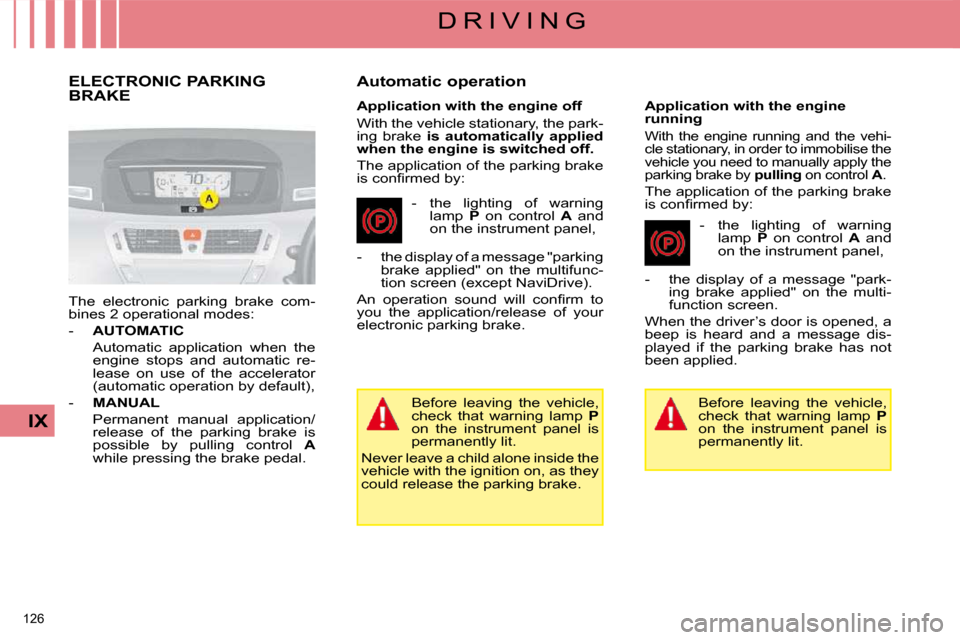
126
IX
D R I V I N G
ELECTRONIC PARKING BRAKE
The electronic parking brake com-
bines 2 operational modes:
- AUTOMATIC
Automatic application when the engine stops and automatic re-
lease on use of the accelerator
(automatic operation by default),
- MANUAL
Permanent manual application/ release of the parking brake is
possible by pulling control A
while pressing the brake pedal. Automatic operation
Application with the engine off
With the vehicle stationary, the park-
ing brake
is automatically applied
when the engine is switched off.
The application of the parking brake
�i�s� �c�o�n�fi� �r�m�e�d� �b�y�:� Application with the engine
running
With the engine running and the vehi-
cle stationary, in order to immobilise the
vehicle you need to manually apply the
parking brake by
pulling on control A .
The application of the parking brake
�i�s� �c�o�n�fi� �r�m�e�d� �b�y�:�
- the lighting of warning
lamp P on control A and
on the instrument panel,
Before leaving the vehicle,
check that warning lamp P
on the instrument panel is
permanently lit.
Never leave a child alone inside the
vehicle with the ignition on, as they
could release the parking brake.
- the display of a message "parking
brake applied" on the multifunc-
tion screen (except NaviDrive).
� �A�n� �o�p�e�r�a�t�i�o�n� �s�o�u�n�d� �w�i�l�l� �c�o�n�fi� �r�m� �t�o�
you the application/release of your
electronic parking brake. - the lighting of warning
lamp P on control A and
on the instrument panel,
- the display of a message "park- ing brake applied" on the multi-
function screen.
When the driver’s door is opened, a
beep is heard and a message dis-
played if the parking brake has not
been applied.
Before leaving the vehicle,
check that warning lamp P
on the instrument panel is
permanently lit.
Page 166 of 330

132
IX
D R I V I N G
4
SITUATION
CONSEQUENCES
5 Display of message
"
Parking brake faulty
"
and the following warning lamps:
� � � � � � � � � � � � � �a�n�d�/�o�r� � � � � � � � � � � � � � � �fl� �a�s�h�i�n�g� - The automatic functions are deactivated.
- The hill start assist is unavailable.
To apply the electronic parking brake:
� Immobilise the vehicle and switch off the ignition
� Pull the control lever for at least 5 seconds or until maximum
application.
� Switch on the ignition and check that the electronic parkin g
brake warning lamps are on.
- Application may take longer than in normal operation.
- If warning lamp P� � �fl� �a�s�h�e�s� �o�r� �i�f� �t�h�e� �w�a�r�n�i�n�g� �l�a�m�p�s� �d�o� �n�o�t� �c�o�m�e�
on when the ignition is switched on, this method does not work.
Have it checked by a CITROËN dealer.
To release the electronic parking brake:
� Switch on the ignition.
� Pull the control lever and hold it for approximately 3 second s.
Display of message "
Parking brake control
faulty – automatic mode activated" and
the following warning lamps:
� � � � � � � � � � � � � �a�n�d�/�o�r� � � � � � � � � � � � � � �fl� �a�s�h�i�n�g� - Only the functions for automatic application on switchi
ng off
the engine and automatic release on acceleration are avail-
able.
- Manual application/release of the electronic parking brake and
dynamic emergency braking are unavailable.
6 Battery fault - Lighting of the battery warning lamp ma
kes it essential to stop
�t�h�e� �v�e�h�i�c�l�e� �a�s� �s�o�o�n� �a�s� �t�r�a�f�fi� �c� �a�l�l�o�w�s�.� �S�t�o�p� �a�n�d� �i�m�m�o�b�i�l�i�s�e� �y�o�u�r�
vehicle.
- Apply the electronic parking brake before switching off the
engine.
Page 168 of 330

134
IX
D R I V I N G
5-SPEED MANUAL GEARBOX
Starting the vehicle
� Check that the gear lever is in
neutral.
� Do not touch the accelerator.
� For Diesel engines: turn the key
to position M and wait until the
pre-heating warning light switch-
es off if it has come on.
� Operate the starter, turning the
key until the engine starts (no
more than ten seconds).
� In temperatures lower than 0 °C,
declutch whilst turning the starter
to facilitate starting.
(6-SPEED) ELECTRONIC GEARBOX SYSTEM
The (6-speed) electronic gearbox of-
fers a choice between the comfort of
fully automatic operation or the driving
pleasure of manual gear changing.
Therefore, you have a choice of two
driving modes:
- the automatic mode for auto-
matic control of the gears by the
gearbox,
- the sequential mode for manu-
al changing of the gears by the
driver.
� automatic mode: selector 2 in
position A .
� manual mode: selector 2 in posi-
tion M .
In automatic mode, instant manual
operation is possible any time you
action one of the levers 1 .
Mode selection
Only engage reverse gear when
the vehicle is stationary with the
engine at idle.
Engaging reverse gear
� Push the gear lever to the right
then rearwards.
Page 169 of 330
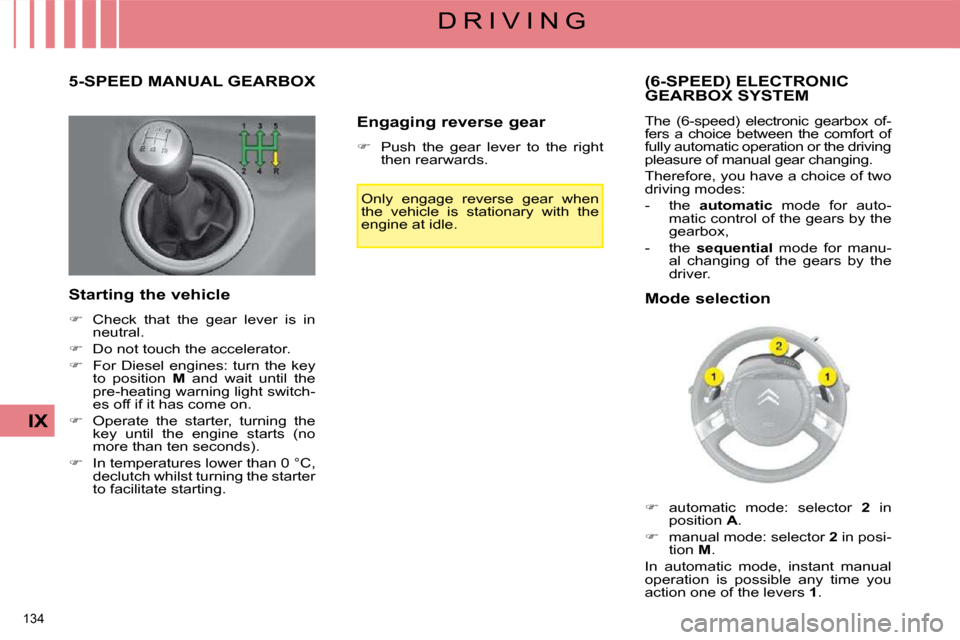
134
IX
D R I V I N G
5-SPEED MANUAL GEARBOX
Starting the vehicle
� Check that the gear lever is in
neutral.
� Do not touch the accelerator.
� For Diesel engines: turn the key
to position M and wait until the
pre-heating warning light switch-
es off if it has come on.
� Operate the starter, turning the
key until the engine starts (no
more than ten seconds).
� In temperatures lower than 0 °C,
declutch whilst turning the starter
to facilitate starting.
(6-SPEED) ELECTRONIC GEARBOX SYSTEM
The (6-speed) electronic gearbox of-
fers a choice between the comfort of
fully automatic operation or the driving
pleasure of manual gear changing.
Therefore, you have a choice of two
driving modes:
- the automatic mode for auto-
matic control of the gears by the
gearbox,
- the sequential mode for manu-
al changing of the gears by the
driver.
� automatic mode: selector 2 in
position A .
� manual mode: selector 2 in posi-
tion M .
In automatic mode, instant manual
operation is possible any time you
action one of the levers 1 .
Mode selection
Only engage reverse gear when
the vehicle is stationary with the
engine at idle.
Engaging reverse gear
� Push the gear lever to the right
then rearwards.
Page 170 of 330
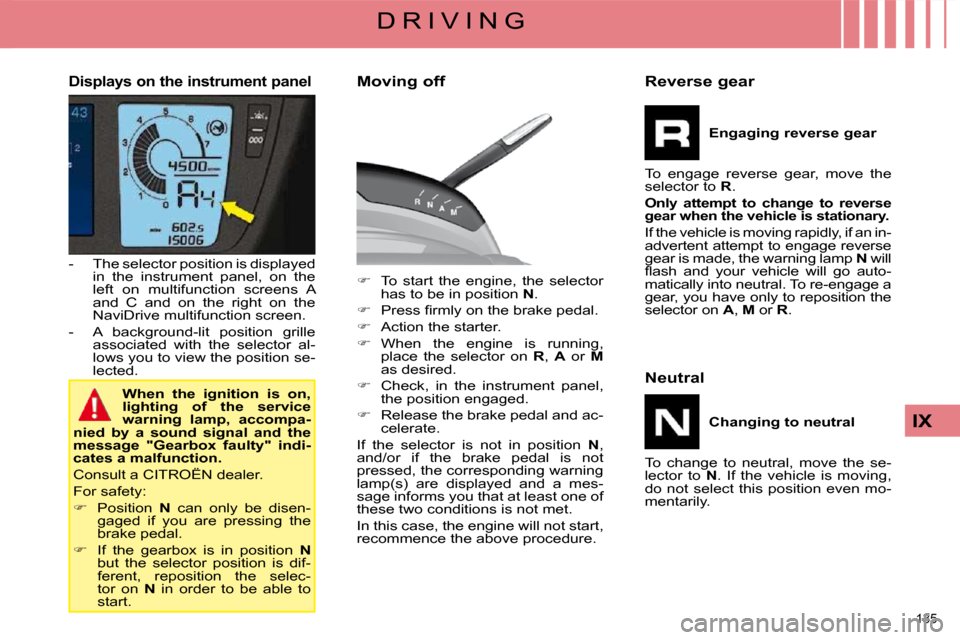
135
IX
D R I V I N G
Displays on the instrument panel
- The selector position is displayed in the instrument panel, on the
left on multifunction screens A
and C and on the right on the
NaviDrive multifunction screen.
- A background-lit position grille associated with the selector al-
lows you to view the position se-
lected.
When the ignition is on,
lighting of the service
warning lamp, accompa-
nied by a sound signal and the
message "Gearbox faulty" indi-
cates a malfunction.
Consult a CITROËN dealer.
For safety:
� Position N can only be disen-
gaged if you are pressing the
brake pedal.
� If the gearbox is in position N
but the selector position is dif-
ferent, reposition the selec-
tor on N in order to be able to
start. Moving off
� To start the engine, the selector
has to be in position N .
� � � �P�r�e�s�s� �fi� �r�m�l�y� �o�n� �t�h�e� �b�r�a�k�e� �p�e�d�a�l�.�
� Action the starter.
� When the engine is running,
place the selector on R , A or M
as desired.
� Check, in the instrument panel,
the position engaged.
� Release the brake pedal and ac-
celerate.
If the selector is not in position N ,
and/or if the brake pedal is not
pressed, the corresponding warning
lamp(s) are displayed and a mes-
sage informs you that at least one of
these two conditions is not met.
In this case, the engine will not start,
recommence the above procedure. Reverse gear
Engaging reverse gear
To engage reverse gear, move the
selector to R .
Only attempt to change to reverse
gear when the vehicle is stationary.
If the vehicle is moving rapidly, if an in-
advertent attempt to engage reverse
gear is made, the warning lamp N will
�fl� �a�s�h� �a�n�d� �y�o�u�r� �v�e�h�i�c�l�e� �w�i�l�l� �g�o� �a�u�t�o�-
matically into neutral. To re-engage a
gear, you have only to reposition the
selector on A , M or R .
Neutral
Changing to neutral
To change to neutral, move the se-
lector to N . If the vehicle is moving,
do not select this position even mo-
mentarily.
Page 181 of 330
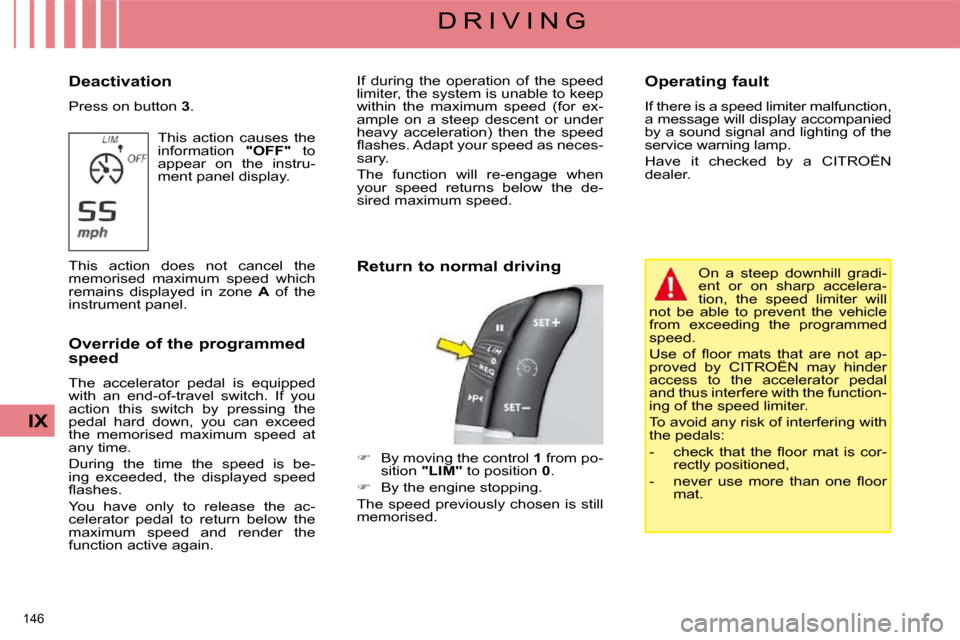
146
IX
D R I V I N G
Deactivation
Press on button 3 .
This action causes the
information "OFF" to
appear on the instru-
ment panel display.
This action does not cancel the
memorised maximum speed which
remains displayed in zone A of the
instrument panel.
Override of the programmed
speed
The accelerator pedal is equipped
with an end-of-travel switch. If you
action this switch by pressing the
pedal hard down, you can exceed
the memorised maximum speed at
any time.
During the time the speed is be-
ing exceeded, the displayed speed
�fl� �a�s�h�e�s�.�
You have only to release the ac-
celerator pedal to return below the
maximum speed and render the
function active again. Return to normal driving
� By moving the control 1 from po-
sition "LIM" to position 0 .
� By the engine stopping.
The speed previously chosen is still
memorised. Operating fault
If there is a speed limiter malfunction,
a message will display accompanied
by a sound signal and lighting of the
service warning lamp.
Have it checked by a CITROËN
dealer.
If during the operation of the speed
limiter, the system is unable to keep
within the maximum speed (for ex-
ample on a steep descent or under
heavy acceleration) then the speed
�fl� �a�s�h�e�s�.� �A�d�a�p�t� �y�o�u�r� �s�p�e�e�d� �a�s� �n�e�c�e�s�-
sary.
The function will re-engage when
your speed returns below the de-
sired maximum speed.
On a steep downhill gradi-
ent or on sharp accelera-
tion, the speed limiter will
not be able to prevent the vehicle
from exceeding the programmed
speed.
� �U�s�e� �o�f� �fl� �o�o�r� �m�a�t�s� �t�h�a�t� �a�r�e� �n�o�t� �a�p�-
proved by CITROËN may hinder
access to the accelerator pedal
and thus interfere with the function-
ing of the speed limiter.
To avoid any risk of interfering with
the pedals:
� � � �-� � �c�h�e�c�k� �t�h�a�t� �t�h�e� �fl� �o�o�r� �m�a�t� �i�s� �c�o�r�- rectly positioned,
� � �-� � �n�e�v�e�r� �u�s�e� �m�o�r�e� �t�h�a�n� �o�n�e� �fl� �o�o�r� mat.